 Credit: NASA
Credit: NASAWhile
Neptune may be the farthest of the eight planets orbiting the
Sun (as
defined by the
International Astronomical Union (IAU)), it certainly doesn't lack for interesting features. While
Uranus' atmosphere is primarily a mix of
hydrogen,
helium and
methane (the last giving the planet its light blue hue),
Neptune's atmosphere is primarily made up of methane, which is what gives the planet its deep blue color. Neptune is the smallest of the four
gas giants, but it's also the densest of that set.
Although
Neptune receives only 3% as much sunlight as
Jupiter, it showed several large dark spots reminiscent of
Jupiter's hurricane-like storms. The largest spot is named the "
Great Dark Spot" and is an
anticyclone similar to
Jupiter's Great Red Spot. Neptune's Great Dark Spot is comparable in size, relative to the planet, and at the same latitude (22° South latitude) as Jupiter's Great Red Spot. However, Neptune's Great Dark Spot is far more variable in size and shape than the Great Red Spot. Another spot, named "
D2" by the
Voyager 2 scientists, is located far to the south of the Great Dark Spot, at 55° South latitude. It is almond-shaped, with a bright central core, and moves eastward around the planet in about 16 hours.
Most of the winds on Neptune blow in a westward direction, which is
retrograde, or opposite to the rotation of the planet. Near the Great Dark Spot, there are retrograde winds blowing up to 1,500 miles an hour (2,400 kph) -- the strongest winds measured on any planet, including windy
Saturn.
The only spacecraft to date to fly past Neptune was
Voyager 2, which hurtled past Neptune's north pole on August 25, 1989. Voyager 2's closest approach was a mere 4,950 km from the planet, the closest approach Voyager 2 made of any planet. The fly-by of Neptune put Voyager 2 on a course 48° south of the ecliptic plane of the solar system, roughly toward the constellation
Canis Major and the star
Sirius, with a rate of speed about 470 million km per year.
 Credit: ESA/NASA
Credit: ESA/NASA





